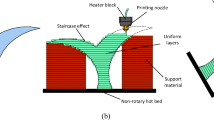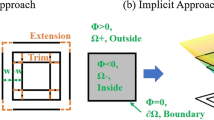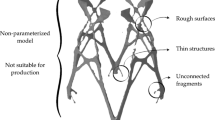Abstract
Wire and arc additive manufacturing (WAAM) has emerged as a promising technique for manufacturing parts with slender features and thin-walled structures. Nevertheless, the utilization of conventional contour-parallel tool paths, with constant offset intervals from the model boundary, leads to filling defects such as underfilling and overfilling. These defects detrimentally affect manufacturing speed, model accuracy, and the structural integrity of the final products. To address these challenges and enhance manufacturing speed, model accuracy, and defect reduction, this paper presented two path-planning methods specifically tailored for thin-walled features. Both proposed methods were built upon the concept of the polygon straight skeleton. The first method was specifically tailored for simple thin-walled parts with a uniform wall thickness, enabling the generation of both closed and open paths. This approach effectively reduced the path length and significantly enhanced printing efficiency compared to conventional contour-parallel tool paths. The second method, in combination with the level-set method, was designed to tackle thin-walled parts with non-constant wall thickness, enabling the generation of paths with variable deposition widths. This adaptive approach ensured precise and efficient material deposition. To verify the efficacy of the proposed path planning methods, a series of printing experiments were conducted for the first method, while comprehensive planning results were obtained for the second method. The proposed path planning methods demonstrate potential applicability across various geometries.























Similar content being viewed by others
References
Dilberoglu UM, Gharehpapagh B, Yaman U, Dolen M (2017) The role of additive manufacturing in the era of industry 4.0. Procedia Manuf 11:545–554. https://doi.org/10.1016/j.promfg.2017.07.148
Ding D, Pan Z, Cuiuri D, Li H (2015) Wire-feed additive manufacturing of metal components: technologies, developments and future interests. Int J Adv Manuf Technol 81:465–481. https://doi.org/10.1007/s00170-015-7077-3
Williams SW, Martina F, Addison AC, Ding J, Pardal G, Colegrove P (2016) Wire+ arc additive manufacturing. Mater Sci Technol 32(7):641–647. https://doi.org/10.1179/1743284715Y.0000000073
Michel F, Lockett H, Ding J, Martina F, Marinelli G, Williams S (2019) A modular path planning solution for Wire+ Arc Additive Manufacturing. Robot Comput-Integr Manuf 60:1–11. https://doi.org/10.1016/j.rcim.2019.05.009
Wang X, Fang P, Teng B, Xu K, Sun H, Wang X (2020) Design of WAAM System Based on Industrial Robot. In: International Conference on Robotic Welding, Intelligence and Automation. Springer Nature Singapore, Singapore, pp 91–106. https://doi.org/10.1007/978-981-19-6149-6_5
Mehnen J, Ding J, Lockett H, Kazanas P (2011) Design for wire and arc additive layer manufacture. In: Global Product Development: Proceedings of the 20th CIRP Design Conference, Ecole Centrale de Nantes, Nantes, France, 19th-21st April 2010. Springer Berlin Heidelberg, pp 721–727. https://doi.org/10.1007/978-3-642-15973-2_73
Ren L, Sparks T, Ruan J, Liou F (2010) Integrated process planning for a multiaxis hybrid manufacturing system. J Manuf Sci Eng 132(2). https://doi.org/10.1115/1.4001122
Campocasso S, Chalvin M, Reichler AK, Gerbers R, Dröder K, Hugel V, Dietrich F (2018) A framework for future CAM software dedicated to additive manufacturing by multi-axis deposition. Procedia CIRP 78:79–84. https://doi.org/10.1016/j.procir.2018.08.314
Chen N, Frank M (2019) Process planning for hybrid additive and subtractive manufacturing to integrate machining and directed energy deposition. Procedia Manuf 34:205–213. https://doi.org/10.1016/j.promfg.2019.06.140
Stavropoulos P, Foteinopoulos P, Papacharalampopoulos A, Bikas H (2018) Addressing the challenges for the industrial application of additive manufacturing: Towards a hybrid solution. Int J Lightweight Mater Manuf 1(3):157–168. https://doi.org/10.1016/j.ijlmm.2018.07.002
Behandish M, Nelaturi S, de Kleer J (2018) Automated process planning for hybrid manufacturing. Comput Aided Des 102:115–127. https://doi.org/10.1016/j.cad.2018.04.022
Nayyeri P, Zareinia K, Bougherara H (2022) Planar and nonplanar slicing algorithms for fused deposition modeling technology: A critical review. Int J Adv Manuf Technol 119(5-6):2785–2810. https://doi.org/10.1007/s00170-021-08347-x
https://github.com/Ultimaker/CuraEngine. Accessed on 14 February 2023
https://www.cgal.org/. Accessed on 14 February 2023
Ding D, Pan Z, Cuiuri D, Li H (2015) A practical path planning methodology for wire and arc additive manufacturing of thin-walled structures. Robot Comput-Integr Manuf 34:8–19. https://doi.org/10.1016/j.rcim.2015.01.003
Ding D, Pan Z, Cuiuri D, Li H, Larkin N (2016) Adaptive path planning for wire-feed additive manufacturing using medial axis transformation. J Clean Prod 133:942–952. https://doi.org/10.1016/j.jclepro.2016.06.036
Xiong Y, Park SI, Padmanathan S, Dharmawan AG, Foong S, Rosen DW, Soh GS (2019) Process planning for adaptive contour parallel toolpath in additive manufacturing with variable bead width. Int J Adv Manuf Technol 105:4159–4170. https://doi.org/10.1007/s00170-019-03954-1
Kuipers T, Doubrovski EL, Wu J, Wang CC (2020) A framework for adaptive width control of dense contour-parallel toolpaths in fused deposition modeling. Comput Aided Des 128:102907. https://doi.org/10.1016/j.cad.2020.102907
Blum H (1967) A transformation for extracting new descriptions of shape. In: Models for the perception of speech and visual form, pp 362–380
Aichholzer O, Alberts D, Aurenhammer F, Gärtner B (1995) Straight skeletons of simple polygons. In: Proc. 4th Internat. Symp. of LIESMARS, pp 114–124
Felkel P, Obdrzalek S (1998) Straight skeleton implementation. In: Proceedings of spring conference on computer graphics, pp 210–218
Cacciola F (2004, June) A CGAL implementation of the Straight Skeleton of a Simple 2D Polygon with Holes. In: 2nd CGAL user workshop (Vol. 1)
Huber S, Held M (2011) Theoretical and practical results on straight skeletons of planar straight-line graphs. In: Proceedings of the twenty-seventh annual symposium on Computational geometry, pp 171–178. https://doi.org/10.1145/1998196.1998223
Osher S, Fedkiw RP (2005) Level set methods and dynamic implicit surfaces. Springer, New York
Ding D, Shen C, Pan Z, Cuiuri D, Li H, Larkin N, van Duin S (2016) Towards an automated robotic arc-welding-based additive manufacturing system from CAD to finished part. Comput Aided Des 73:66–75. https://doi.org/10.1016/j.cad.2015.12.003
Acknowledgments
The authors appreciate the support of National Natural Science Foundation of China (62076095, 61973120), National key research and development program (2022YFB4602100).
Author information
Authors and Affiliations
Corresponding author
Ethics declarations
Ethical approval
The authors declare that there is no ethical issue applied to this article.
Consent to participate
The authors declare that all authors have read and approved to submit this manuscript to IJAMT.
Consent for publication
The authors declare that all authors agree to sign the transfer of copyright for the publisher to publish this article upon acceptance.
Competing interests
The authors declare that they have no competing interests.
Additional information
Publisher’s note
Springer Nature remains neutral with regard to jurisdictional claims in published maps and institutional affiliations.
Rights and permissions
Springer Nature or its licensor (e.g. a society or other partner) holds exclusive rights to this article under a publishing agreement with the author(s) or other rightsholder(s); author self-archiving of the accepted manuscript version of this article is solely governed by the terms of such publishing agreement and applicable law.
About this article
Cite this article
Wang, X., Lin, Z., Hua, Y. et al. Straight skeleton filling methods for thin-walled parts. Int J Adv Manuf Technol 130, 267–282 (2024). https://doi.org/10.1007/s00170-023-12665-7
Received:
Accepted:
Published:
Issue Date:
DOI: https://doi.org/10.1007/s00170-023-12665-7




